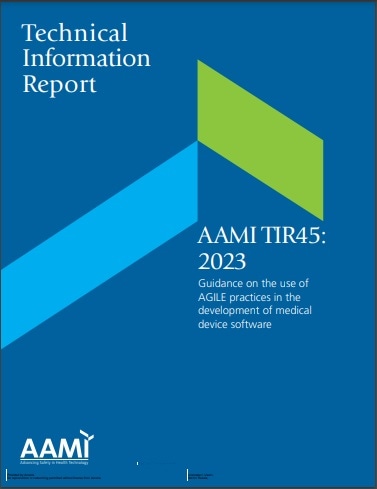AAMI規格 AAMI TIR45, 2023: Guidance on the use of AGILE practices in the development of medical device software, 医療機器ソフトウェア開発におけるアジャイルプラクティスの活用に関するガイダンス
Description
Inclusions
This Technical Information Report (TIR) provides perspectives on the application of AGILE during medical device software development. It relates them to the following existing standards, regulations, and guidance:
— ISO 13485:2016, Quality management systems─Requirements for regulatory purposes;
— IEC 62304:2006+AMD1:2015, Medical device software–Software life cycle processes;
— ISO 14971:2019, Medical devices─Application of risk management to medical devices;
— FDA Code of Federal Regulations (CFR), Title 21, Part 820.30, Quality System Regulation: Design Controls;
— FDA Guidance for the content of premarket submissions for software contained in medical devices;
— FDA General principles of software validation; Final guidance for industry and FDA staff.
Although this TIR does not provide a particular perspective for IEC TR 80002-1 (Guidance on the application of ISO 14971 for medical device software), the pertinent aspects of software risk management for medical devices were integrated throughout this TIR.
The following groups are the intended audience for this TIR:
— Medical device manufacturers who are planning to use AGILE techniques;
— Manufacturers who are currently practicing AGILE and are entering the regulated medical device space;
— Software development teams, including software test and quality groups;
— Software definers, including marketing, sales, and other representatives of the customer;
— Senior management, project managers, quality managers;
— Quality systems and regulatory affairs personnel;
— Internal and external auditors;
— Regulating bodies, agencies, and organizations responsible for overseeing the safety and effectiveness of medical devices.
Exclusions
This TIR is not intended to be used as an educational tool or tutorial for the following:
— AGILE development practice;
— Quality system regulations.
This TIR should be regarded as a reference and as a guidance intended to provide recommendations for complying with international standards and FDA guidance documents when using AGILE practices in the development of medical device software. This TIR is not intended to be a prescription for a specific situation or method.
Organization:
Navigating this document This TIR is organized into three main sections:
1) Setting the stage (Clause 4);
2) Aligning on concepts (Clause 5);
3) Aligning on practices (Clause 6).
Clause 4 provides background information necessary to understand the context of this TIR.
-Subclause 4.1 describes the AGILE perspective, explaining the goals, values, principles, and practices that define AGILE software development. If you are new to the AGILE world, this section is a good place to start.
-Subclause 4.2 describes the regulatory perspective: the goals, values, principles, and practices that define the regulated world of medical device software development. If you are new to the regulatory world, this section is a good place to start.
If you already have a working knowledge of both worlds, you could skip subsection 4.1 and subsection 4.2 and refer to them as necessary when reading other sections of this TIR. Neither of these subsections provides a complete, detailed description of these two perspectives; they provide only enough information to support the context of the rest of the TIR. Additional references are provided for readers who want more information.
-Subclause 4.3 addresses some of the most important topics in aligning the AGILE and regulatory perspectives. It compares and contrasts the things that AGILE values with things that the regulatory perspective values. AGILE values are defined in the Manifesto for AGILE Software Development with statements that can be read as contrary to regulatory values. This subsection provides recommendations on how to align these different values in a supportive way. If the high-level goals and values of either perspective are a source of concern for your organization, this section might be a good place to start.
Clause 5 compares and contrasts some of the high-level concepts that define the AGILE and regulatory perspectives. AGILE provides many detailed practices but emphasizes the need to adapt them to fit the needs of a particular context, so it is important to understand the principles of AGILE when adapting the practices. Regulations and standards provide broad guidance on the requirements for a quality management system and require manufacturers to provide the details that describe their process, so it is important to understand regulatory principles when defining a quality management system. Many principles from these different perspectives align very well, whereas others might provide some challenges. This section provides recommendations on how to align these different principles in a supportive way. If you want to address foundational issues of principles and concepts before getting into details of implementation, this section would be a good place to start.
Clause 6 addresses many details of implementing AGILE in a regulated environment and provides many recommendations and considerations. The section is broken into large topic groups. If you want to get into the details of the specific implementation of a process or practice, this section would be a good place to start.
Most sections highlight an important point relevant to that section’s topic.
The text around these highlights provides more detail to support it.
It is not necessary to read this TIR in order from front to back. There is some repeated information in the various sections to give information needed to understand a topic, and there are cross-references in many sections to point to more information to understand a topic. Read the sections in the order that makes sense to you.
The committee realizes that this TIR covers a wide variety of agile-related topics, and some readers may be interested in just a subset of the topics. For example, some readers may be interested in the day-to-day management of an agile team, other readers may be more interested in how to ensure the activities are compliant with regulations and standards. Annex B has been developed to help readers quickly find guidance regarding agile-related activities that they are interested in.











